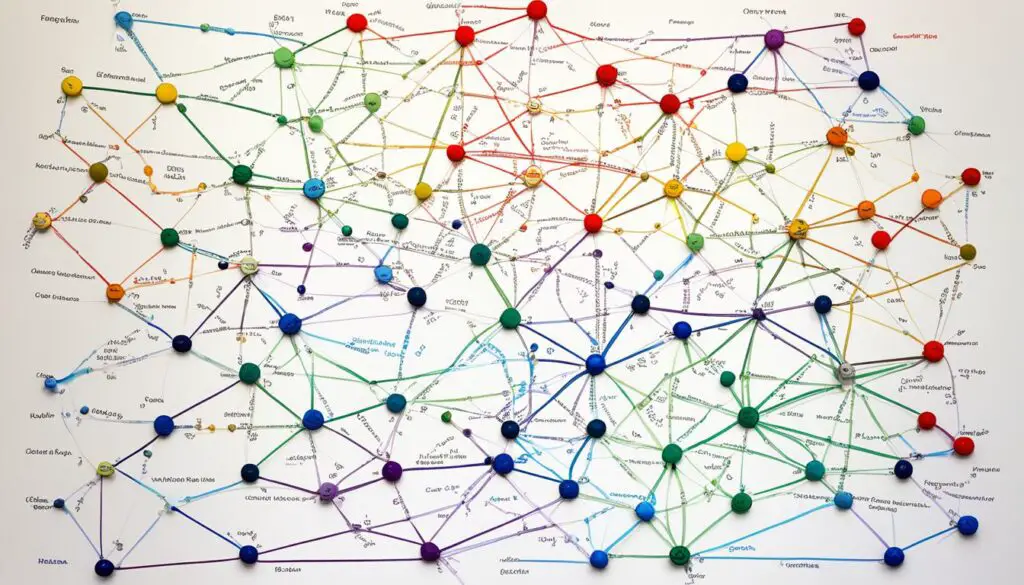In the world of Biblical studies, many are interested in finding deep connections within scripture. A great tool for this is Principal Component Analysis, or PCA. It uses machine learning to show us new views and insights into the Bible’s stories and messages.
This article will cover the basics of PCA and how it can help us understand relationships within the Christian Bible. So let’s start on this exciting journey together, exploring the rich connections within scripture!

Key Takeaways:
- Biblical studies can benefit from utilizing Principal Component Analysis (PCA) to uncover intricate connections in scripture.
- PCA, a machine learning technique, enables fresh perspectives and insights into the content and stories of the Bible.
- In this article, we will explore how PCA works and its applications in analyzing the relationships within the Christian Bible.
The Power of Embeddings in Building the System
Embeddings are key in constructing a system for the Bible text using PCA. They represent information in a big space, showing us how to encode and work with concepts like words. Tools like Word2Vec and Sentence2Vec help change the text into vectors. These tools show us the deep information and links in the Bible, starting the way for PCA analysis.
Embeddings help discover hidden patterns and links in Bible texts. It’s not just about finding keywords. We can look at the real meaning and context. Adding AI methods lets us look deeper into the Bible. This improves our understanding of its meaning.
Word2Vec and Sentence2Vec
Word2Vec and Sentence2Vec make embeddings for text data. Word2Vec turns words into vectors based on how they appear together in a sentence. This shows us the real meaning and the links between words, even synonyms and analogies. Sentence2Vec goes a step further, making vectors for whole sentences or paragraphs. This captures the context and the relationships between different parts of the text.
Word2Vec and Sentence2Vec’s embeddings bridge language with math. Thanks to this, we can do calculations, check similarity, and spot patterns using numbers. This mix of language and math is what lets us use PCA for Bible text analysis.
“Embeddings bring the textual data to life, transforming words and sentences into numerical representations that reveal hidden connections and meaning.” – Author
Using embeddings, we can go into the Bible’s details. We can explore its teachings, tales, and people deeply. The vectors are the base for detailed analysis. This helps us understand the Bible’s different parts better.

Analyzing Biblical Texts with PCA
After creating a system with embeddings, we use Principal Component Analysis (PCA) to study Biblical texts. PCA transforms the data into new coordinates. These new numbers show us the main differences in the Bible. So, it helps to find themes and links between concepts, stories, or verses.
Using PCA means we make a correlation matrix for the Bible. This measures how closely related different parts are. If we see a high correlation between stories, it shows they share a common theme.
PCA also gives us something called loadings. These show which parts of the Bible are most important to the main topics PCA finds. By looking at these, we see what themes or concepts are key. It helps us discover hidden structures or often-repeating ideas.
PCA lets us see the Bible as a social network. This helps us understand the interactions and roles of the characters in the Bible better. Seeing these connections visually deepens our Bible study.
Let’s look at the Bible’s social network to understand PCA’s insights better:

By analyzing the Bible as a social network, we see how its stories, themes, and characters connect. This exploration deepens our understanding of the Bible’s narrative.
Using PCA opens a new door for Bible study. It uncovers hidden patterns, clarifies relationships, and brings new insights into the text.
Conclusion
In sum, Principal Component Analysis (PCA) is a powerful tool for studying the Bible’s text relationships. It uses math and logic to find deep connections. By doing so, we can see the Bible’s content in new and insightful ways.
This method lets us look at the Bible as if it’s a big, complex social network. We can understand the community it talks about and what its members do. With the help of AI and methods like PCA, we’re getting better at understanding the Bible’s stories.
PCA is very helpful for Bible scholars. It shows us how the Bible’s texts are interconnected. This helps us understand the Bible’s messages better. With PCA, there’s so much we can discover in the Bible. It makes studying it even more interesting.
FAQ
What is Principal Component Analysis (PCA)?
Principal Component Analysis (PCA) finds hidden links in Bible. It uses advanced computer methods. These methods help people see Bible stories in new ways.
How can PCA be applied to Biblical studies?
PCA brings new views to Bible stories. It shows connections we might not have noticed before.
What are embeddings and how do they relate to analyzing Biblical texts with PCA?
Embeddings are like road maps but for information. They guide us in understanding Biblical texts. Tools like Word2Vec help turn Bible wisdom into these maps.
What is the role of PCA in analyzing Biblical texts?
PCA turns data into a clearer form. It helps find hidden patterns in Bible stories. It uncovers how different parts of the Bible relate.
How can the relationships within the Bible be visualized using PCA?
PCA turns Bible stories into a social network. It shows us how Bible characters connect. This gives a new way to look at the Bible’s community.








